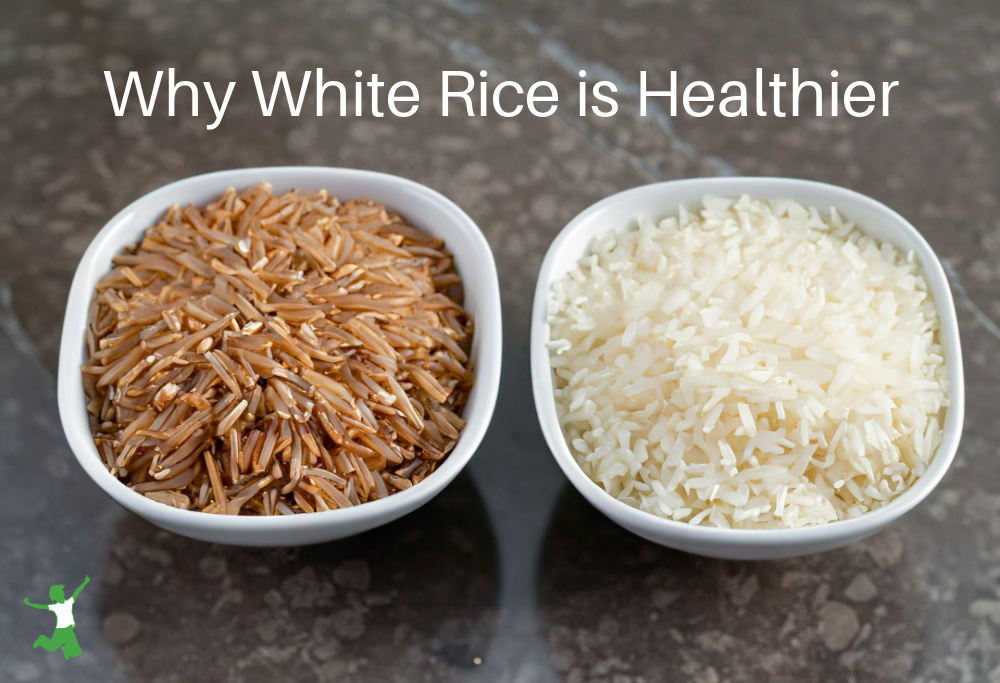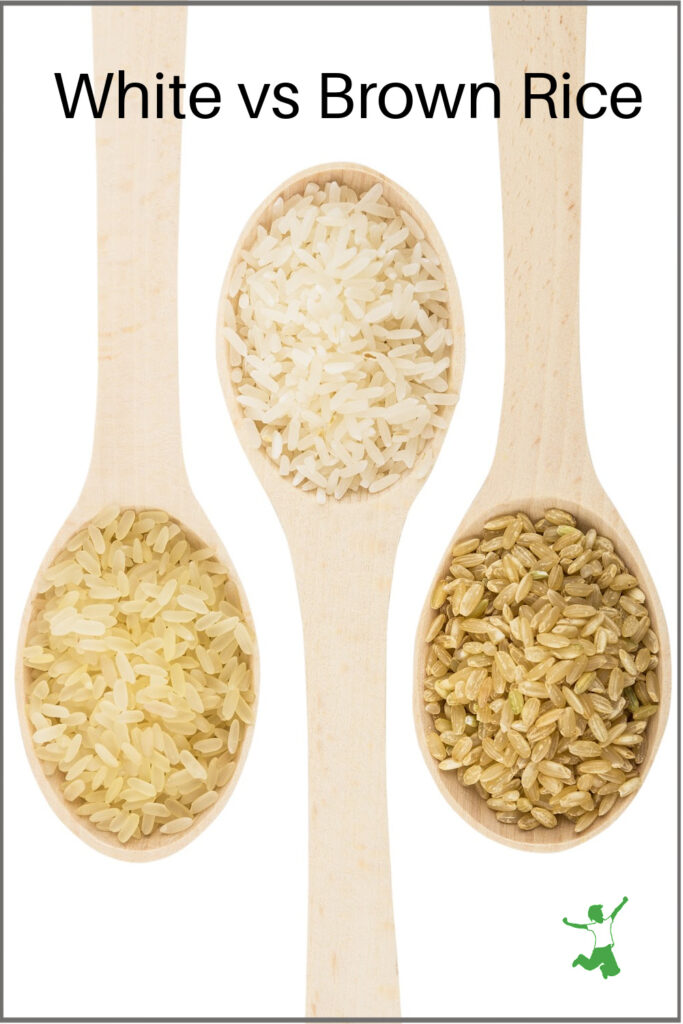The reasons white rice is healthier than brown rice as determined by research as well as which type traditional societies preferred consuming.

My article and video on healthy Chinese food drew some comments from readers who questioned my choice of rice.
Why was I using white rice vs brown? Isn’t brown rice the healthier choice, after all?
Ok, I’ll spill the beans, rice. Here are my reasons …
The truth is, neither my husband nor myself have ever enjoyed brown rice (although we love the nutty flavor and digestibility of wild rice).
Every time we eat brown, it just seems to not sit very well in our stomachs.
Even when it is sprouted or soaked before cooking, it, well, uh, sits like a brick for lack of a better word.
Why Some People Should Eat White Rice
White rice just seems to digest a whole lot better for us. That to me was reason enough to choose it over the brown rice.
We were also advised by an Ayurvedic MD back in the 1990s to stick with white basmati rice. This recommendation clinched the decision.
You are what you digest, after all – not necessarily what you eat!
End of story? Well, not quite.
Rice Fiber in Brown Harms a Compromised Gut
A few years back at the annual Wise Traditions Conference, I became familiar with a compelling book called Fiber Menace.
The author writes extensively about the dangers of a high-fiber diet as it pertains to a menu loaded with whole grains as pushed by the misguided Food Pyramid.
In other words, folks who eat a bowl of All Bran every morning to keep the bathroom visits regular are unknowingly ripping their insides to shreds.
The basic premise of Fiber Menace is that grain fiber plays a leading role in many gut-related ailments including colon cancer.
When I first learned of this information, my preference for white rice over brown rice started to make more sense.
Perhaps the brown rice didn’t digest that well because of all that fiber?
Chalk one up for the white rice.
White Rice Far Lower in Phytic Acid
A second piece of information came from author Ramiel Nagel.
In his book, Cure Tooth Decay, he writes about the devastating effects of phytic acid in the diet. Phytic acid is a very powerful antinutrient and blocker of mineral absorption in the gut.
Mr. Nagel identifies brown rice as very high in phytic acid.
What’s more, soaking brown rice does not reduce phytic acid by much at all!
Polished Rice is the Ancestral Form
Ramiel also maintains that the traditional method for preparing brown rice is never to eat it whole (with only the husk removed).
Rather, ancestral societies pounded brown rice in a mortar and pestle to polish it by removing the outer bran layer. This is the primary source of the phytic acid.
Nagel goes on to point out that experiments have shown that the milled and polished rice that results from this pounding process, has the highest mineral absorption.
In short, mineral absorption from whole brown rice is much less than white polished rice. This is because the phytic acid in the bran which is not reduced much by soaking, greatly interferes with the absorption process.
What About Arsenic?
A big issue with arsenic contamination in rice has emerged in recent years. Some folks have responded by no longer eating rice at all.
This is an overreaction, in my view.
Clean rice is definitely available if you know what to look for.
This article on how to avoid arsenic in rice details what to do. While soaking brown rice barely moves the needle on phytic acid, soaking white rice before cooking removes nearly all the arsenic!
Another option is to parboil white rice before using fresh water for a full cook if you don’t have time to soak.
Is White Rice Better Than Brown?
So it seems that brown rice is not necessarily a healthier choice than milled white rice.
Black or red rice would fall into the same category.
Obviously, whether you choose one or the other is a personal preference, but I hope this information helps you sort through the decision with a bit more clarity.
As for me and my family, we will be sticking with white basmati and jasmine rice (white basmati rice is more nutritious than plain white rice).
I currently buy this brand of rice in 25-pound bags as the most economical and high-quality choice.
Observation clued me in many years ago that brown rice was not something that was sitting well in my stomach or my husband’s.
As the years go by, more research is coming forth to indicate that this decision was the right way to go after all.
Do you eat white rice or brown rice in your home? Why or why not?

References
(1) Fiber Menace
(2) Living with Phytic Acid
More Information
Macrobiotic Diet and Extreme Vitamin D Deficiency
Tiny Teff Grains Deliver Big on Nutrition
How to Make Perfect Yellow Rice (Arroz Amarillo)
Millet: Healthy or Not?
Do Whole Grains Cause Cavities?








In India we have always eaten white rice but it is hand pounded and not milled. They say it helps absorb vitamins and minerals better than brown rice. Any sources of hand pounded white rice available in USA?
brown rice due to phytates makes your mineral absorption poor.
Why are you spamming this article? Weird people.
I’ve been researching how to soak rice and it was surprisingly difficult to find good info. The comments to this article backed up the process I recently adopted which is to soak white rice overnight in water with a tad of whey/yogurt/kefir then to rinse, soak and “massage” it like kneading bread, then rinse again until the water is clear. Not only does it reduce phytates, but also the starch content which is also hard on the gut. We can definitely feel the difference in our tummies. BTW we are on the GAPS diet and occasionally cheat with rice prepared this way.
how do Konstantin Monastyrsky’s ideas look in light of the new findings on prebiotics?
Hi Sarah!
Do you happen to know about “Rice Bran Solubles” and whether that food has significant amounts of phytic acid? It’s sold as a “super food” and has claims of high amounts of nutrients. It also tastes amazing. I’m curious what your take is on it.
Thank you!
Not heard of it or investigated it as of yet. Will look into it!
Been a brown rice fan for years, even eat my sushi with it but between this post (also a fan of Mr. Monastyrsky) and the below article stating brown rice has more arsenic in it than its white counterpart, then white may be right!
consumerreports.org/cro/magazine/2015/01/how-much-arsenic-is-in-your-rice/index.htm
Sushi gives you parasites
Only if you’re munching on a raw fish straight from the supermarket. Sushi Grade fish undergoes a freezing process to kill parasites.
My diabetic husband has trouble with plain white rice – it always SPIKES his blood sugar, brown rice doesn’t. But since the kids didn’t like it at first, we started mixing the two, half and half, to ease them into it – and surprise! both problems were solved – the flavor is good, and the blood sugar is managed. (We cook it in the rice cooker on the white rice setting!) But I think I might start soaking ithe brown rice beforehand. This was enlightening. Thanks for the info.
Asians have a higher risk to heart attacks bec of consumption of white rice. I see/hear news of someone getting a heart attack in my community (Philippines) very often. I’ve switched to brown rice. It is a challenge to cook, but the benefits are worth it.
@Mike
You might need to check your facts: South Korea and Japan rank extremely low for heart problems + Thailand and China are in the lower bracket. All those asian countries eat white rice.
Philippines has a host of other problems that may and probably increases it’s heart attacks: irregular doctor visits (preventive care), low wages and poor economic conditions that increase stress and a diet choices with too many western fast food choices + a regular diet that lacks fresh vegetables while being meat heavy.
White rice is the least of problems.
We do not eat rice very often, but when we do, it is a mix of red, brown, white and wild rice that we pressure cook in bone broth with home grown black currants that is soaked overnight before it is cooked. We do need both soluble and insoluble fiber in our diets, and each person is different in the way his or her body system handles fiber. Sometimes it is hard to keep up with all of this nutrition information. My grandmother, who lived to be 103, in her later life ate white Wonder bread and store-bought mayonnaise with tomatoes in between two slices for half of her meals – she never heard of any of this stuff we discuss so profusely {:0) We grind our own locally-grown wheat – mostly for sourdough flatbreads – and make our own butter, yogurt and fresh yogurt cheese from local raw milk – and homemade mayo from farm-fresh eggs and olive oil – and I don’t know if I’ll live to be 103 or not! I do enjoy learning new nutritional facts, though, and appreciate all of the research you do!
Christian Mountain Mama!
Your rice dish sounds A.M.A.Z.I.N.G!!!. Any chance of you sharing the recipe?
I want to come to your home to eat!! 🙂
EWWWWW white rice tastes better? It HAS NO FLAVOR!!! I don’t like white rice because I don’t like processed foods. Brown rice has texture and flavor.. White rice tastes very bland to me- a tick processed white mess.
ok, seriously. Lets set (y)our preconceived notions, and stubborn dense biases aside…
White rice is NOT “processed”. Period.
It is just peeled. Basic exact same thing.
Flavor subject, i’ll digress. They both have their strengths and weaknesses, especially in relation to food (many recipes’ flavors (not to mention nutrients) are absorbed by white rice much better). But you are being completely irresponsible, if not ridiculous using the word “processed” with its modern definitions and connotations regarding food today that mean something entirely different than what white rice truthfully is.
The rice grain without its shell. Or skin.
Period. End of.
And i wont even address your “EWWW” part.
The “eww” part is that person’s own particular “taste” which we all have. We are all different….we don’t all like the same things.
I think many people are confused when referring to “white” rice and “brown” rice. The junk you can get on every grocery store shelf in the U.S. is called white rice and has little to no nutritional value. The author of this article is speaking of white Basmati rice vs. brown Basmati rice. Basmati is a tasty rice and nutritious. Also, Mike Adams (AKA The health ranger) tested rice in his lab and found that all rice had high levels of arsenic except an organic brand from California-even testing many imported from overseas. So there you go. Stick to organically grown rice from a large organic rice farm in Cali. to assure you are keeping your arsenic levels down. I’m not mentioning the name so as not to promote a company but if you do your research you will easily find this large scale organic rice producer 😉
We use white basmati rice from India in our home. Indian white basmati rice is one of the types that is lowest in arsenic.
We used to use exclusively brown rice, but when I found out that it was high in arsenic, we’ve switched. True, brown rice has somewhat more nutrients, but when many types have more arsenic in one serving, than is even legally allowed in our drinking water, I don’t feel comfortable eating it on a regular basis.